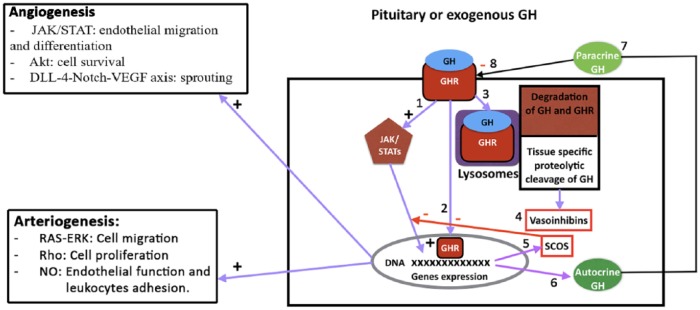Figure 10.
Intracellular mechanisms by which GH produces angiogenesis or arteriogenesis or may be inactivated. (1) After the interaction between GH and its receptor (GHR) a cascade of signaling pathways is initiated by JAK2 activation leading to the expression of a number of genes. (2) The GHR may be internalized together with GH and translocated to the nucleus where it may also activate gene expression. (3) GH and GHR may suffer a lysosomal degradation after being internalized, but also, depending on the tissue, the hormone may suffer a specific proteolytic cleavage giving origin to vasoinhibins (4) which may block both angiogenesis and arteriogenesis. This represents a mechanism of control for both processes. (5) Among the genes expressed SOCS acts by inhibiting GH signaling, directly or affecting the translocation of the GHR to the nucleus of the cell. (6, 7) Cells may express GH that acts in an autocrine (6) or paracrine (7) manner. This cellular production of the hormone may lead to an interaction with the membrane GHR (8) impeding the effects of endocrine or exogenously administered hormone, or even may produce the desensitization of GHR.
On the left of the figure, signals responsible for angiogenesis (upper) and arteriogenesis (lower) can be seen. Blue arrows, stimulation; red arrows and squares, inhibition.
+, activation; -, inhibition; Akt, serin threonine kinase; DLL4-Notch-VEGF axis, Delta like 4-Notch-vascular endothelial growth factor axis; GH, growth hormone; GHR, growth hormone receptor; JAK/STATs, Janus kinase/signal transducer and activator of transcription; NO, nitric oxide; RAS-ERK, rats sarcoma-extracellular signal-regulated kinases; Rho, hexameric protein found in prokaryotes, necessary for the process of terminating the transcription of some genes; SOCs, suppressor of cytokine signaling.

